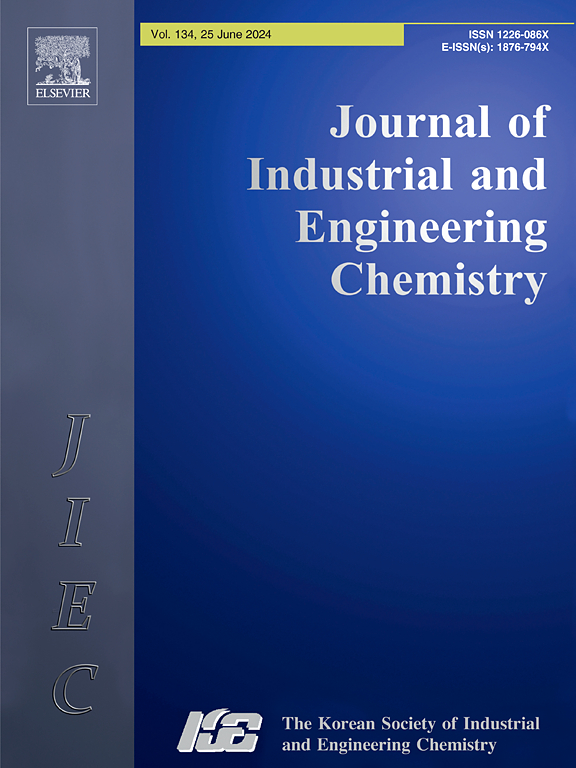Polyimide impregnated silver nanowire-titanium oxide core–shell nanostructures as ultra-stable flexible transparent electrode for multiple applications
IF 5.9
3区 工程技术
Q1 CHEMISTRY, MULTIDISCIPLINARY
Journal of Industrial and Engineering Chemistry
Pub Date : 2024-07-17
DOI:10.1016/j.jiec.2024.07.032
引用次数: 0
Abstract
Silver nanowires (AgNWs)-based flexible-transparent conducting electrode (f-TCE) have various optoelectronic applications. Although, bare AgNW-based f-TCE faces challenges of poor adhesion with the substrate, rough surface and low thermal stability. In this work, we demonstrate preparation of f-TCE by coating a very thin layer of TiO2 over AgNWs to form AgNW-TiO2 core–shell structures. Due to very thin TiO2 film in core–shell structure, the amorphous TiO2 converted into crystalline and delivered excellent conductivity at low curing temperature of 100 °C. The adhesion and roughness issues are solved by impregnating the core–shell AgNW-TiO2 within polyimide (PI) matrix. The PI impregnated AgNW-TiO2 core–shell structure as f-TCE delivered excellent stability after 5000 times of bending and number of peeling off cycles. The as prepared f-TCE delivered sheet resistance (Rs) of 8.61 Ω/sq with transmittance of 85 % at 550 nm and Rs of 4.2 Ω/sq with transmittance of 81 % when cured at 250 °C. The surface temperature of f-TCE was found to increase up to 90 °C in 40 s after applying 4 V of supply indicating its potential as transparent heater. In addition to that the CIGS solar cell fabricated by utilization of our f-TCE exhibited efficiency of 9.6 %, demonstrating its applicability for photovoltaic applications.

聚酰亚胺浸渍银纳米线-氧化钛核壳纳米结构作为多种应用的超稳定柔性透明电极
基于银纳米线(AgNWs)的柔性透明导电电极(f-TCE)具有多种光电应用。然而,基于裸 AgNW 的 f-TCE 面临着与基底附着力差、表面粗糙和热稳定性低等挑战。在这项工作中,我们展示了通过在 AgNW 上涂覆一层极薄的 TiO 以形成 AgNW-TiO 核壳结构来制备 f-TCE 的方法。由于核壳结构中的 TiO 薄膜非常薄,无定形的 TiO 转化为晶体,在 100 ℃ 的低固化温度下具有优异的导电性。在聚酰亚胺(PI)基质中浸渍核壳 AgNW-TiO 解决了附着力和粗糙度问题。作为 f-TCE 的聚酰亚胺浸渍 AgNW-TiO 核壳结构在经过 5000 次弯曲和多次剥离循环后具有出色的稳定性。制备的 f-TCE 在 550 纳米波长下的薄层电阻 (Rs) 为 8.61 Ω/sq,透射率为 85%;在 250 °C 固化时,Rs 为 4.2 Ω/sq,透射率为 81%。在 4 V 的电压下,f-TCE 的表面温度可在 40 秒内升至 90 °C,这表明它具有作为透明加热器的潜力。此外,利用我们的 f-TCE 制作的铜铟镓硒太阳能电池效率高达 9.6%,证明其适用于光伏应用。
本文章由计算机程序翻译,如有差异,请以英文原文为准。
求助全文
约1分钟内获得全文
求助全文
来源期刊
CiteScore
10.40
自引率
6.60%
发文量
639
审稿时长
29 days
期刊介绍:
Journal of Industrial and Engineering Chemistry is published monthly in English by the Korean Society of Industrial and Engineering Chemistry. JIEC brings together multidisciplinary interests in one journal and is to disseminate information on all aspects of research and development in industrial and engineering chemistry. Contributions in the form of research articles, short communications, notes and reviews are considered for publication. The editors welcome original contributions that have not been and are not to be published elsewhere. Instruction to authors and a manuscript submissions form are printed at the end of each issue. Bulk reprints of individual articles can be ordered. This publication is partially supported by Korea Research Foundation and the Korean Federation of Science and Technology Societies.

 求助内容:
求助内容: 应助结果提醒方式:
应助结果提醒方式:


